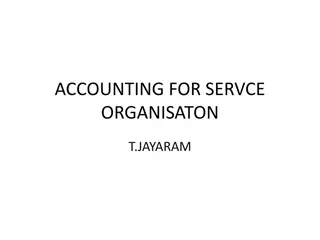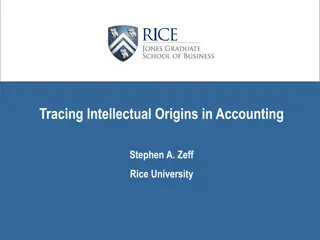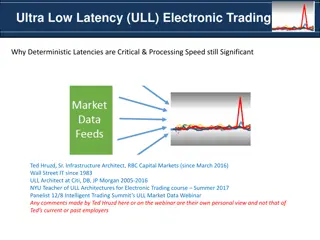Understanding Non-Trading Organizations in Financial Accounting
Non-trading organizations do not aim to profit and provide services without engaging in commercial transactions. Their income sources include donations and grants. Management is handled by committees, and accounting involves principles of double-entry bookkeeping for financial reporting. The main objectives include performance evaluation and goal achievement assessment.
Download Presentation

Please find below an Image/Link to download the presentation.
The content on the website is provided AS IS for your information and personal use only. It may not be sold, licensed, or shared on other websites without obtaining consent from the author. Download presentation by click this link. If you encounter any issues during the download, it is possible that the publisher has removed the file from their server.
E N D
Presentation Transcript
WELCOME WELCOME Class: Class: B.Com B.Com Part Subject: Financial Accounting Subject: Financial Accounting Topic Topic Accounting Of Non Trading Accounting Of Non Trading Organization Organization Part- -1 1 Prepared By Dr. SHAHID IQBAL Guest Faculty Marwari College, Darbhanga, Mobile no. and whatsup no. : 7004160257 Email ID: shahidlnmu@gmail.Com
MEANING OF NON TRADING ORGANISATION: MEANING OF NON TRADING ORGANISATION: A non trading organization is one that does not intends to make profits and this implies that it is not actually involved in trading or selling any thing. In such an organization, the company is not offering its services in return for money instead it offers its services free of cost to the customer. In this way no trade or exchange takes place between the provider and customer and hence they are called non trading organizations. The main sources of income for a non-trading concern are donations, fees and government or municipal grants. The income should generally be received through a proper banking channel in order to provide an audit trail.
Nature of Non Trading Organization: Nature of Non Trading Organization: Service Motive: These organizations have a motive to provide service to its members or a specific group or to the general public. Members: These organizations are formed as charitable trusts or societies. The subscribers to these organizations are their members. Source of Income: The major sources of income of not-for-profit organizations are subscriptions, donations, government grants, legacies, income from investments, etc. Management: The managing committee or the executive committee manages these organizations. The members elect the committee. Reputation: These organizations earn their reputation or goodwill on the basis of the good work done for the welfare of the public. Users of accounting information: The users of the accounting information of these organizations are present and potential contributors as well as the statutory bodies.
Objective of Accounting for Non Trading organization: Objective of Accounting for Non Trading organization: The accounting for a non-trading concern is generally as per the principles of double entry bookkeeping system. They generally only maintain a cash book to record receipts and payments made during the year. The cash book is converted into receipt and payment account at the end of the year. The receipts and payments account is a summarized form of cash book and is considered a more useful source of information for preparing final accounts of the entity. By using information from receipt and payment account and from other sources, the entity prepares its income and expenditure account and balance sheet at the end of the period. The income and expenditure account shows a surplus or deficit for the year and balance sheet shows the assets and liabilities of the entity at the end of the year.
Following are some objectives for accounting for non trading organizations: a) To evaluate the performance of organizations in terms of achieving their goals for which they were created. b) To judge whether those organizations are appropriating the funds with three E s viz. economically, effectively and efficiently. c) To examine the compliance of rules, regulations, bye-laws in the organizations. d) For obtaining grants from government departments. e) 5. To submit annual accounts to the Registrar with whom they are registered.
DIFFERENCE BETWEEN NON TRADING AND TRADING DIFFERENCE BETWEEN NON TRADING AND TRADING ORGANIZATION: ORGANIZATION: Non Trading Organization Trading Organization a) The main objective of these concerns is to earn profit. b) The main sources of income are revenue received from the sale of merchandise or from the services rendered to others. c) Trading concerns may be in the form of sole proprietorship, partnership, joint stock company or public enterprises. a) The concerns is to provide goods and services that fulfill a social need. b) The main sources of income of these concerns are entrance fees, subscriptions, donations, Govt. and municipals grants etc. c) Non-Trading concerns may be in the form of association and trust. main objective of these club, society,
Trading Organization Non Trading Organization d) The control and management of non- trading concerns rest in the hands of trustees, governing body and committee of management. d) Trading Concerns: The sole proprietorship is managed by partnership by the partners or their representatives and joint stock company by the board of directors. the proprietor, the e) The final accounts of such concerns involves income and expenditure A/c, balance sheet. A summary of cash transactions I.e. Receipts and payments account is also prepared. e) The final accounts of such concerns involves Trading account, profit and loss account and balance sheet.

























